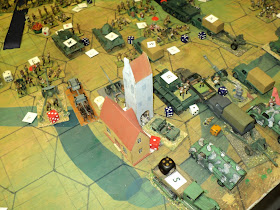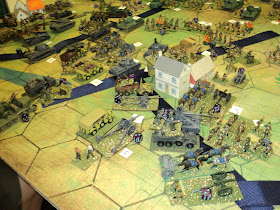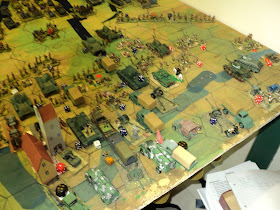 |
| 3rd Romanian Army's front, daybreak, 20 November, 1942. |
Though achieving a breakthrough close by the headwaters of the Tsuskan stream, and a more serious one east of Perelazkovskiy, the Red Army was unable even during the early hours of darkness to exploit on. Overnight the Soviets pulled back a space to recover some of their strength, and to reorganise. The Romanian Army was therefore allowed along most of the front to retain hold of their original defensive locations.
 |
| Soviet right flank, mid-morning 20 November, 1942. |
Of the 63 Soviet and 37 Romanian strength points lost, 24 and 12 could be restored to depleted units. Units destroyed being permanently written off (16 Russian and 14 Romanian), the Soviets were able to recover proportionately more SPs. Even so, such were the losses already taken, that even 24 returned seemed too few to go around. In my previous posting I mentioned a priority system of restoring SPs, but I don't think I used that here in quite such a formal fashion. At any rate,
1st Guards Army received just half their lost 6 SPs in return. I think all I did was return half each unit's losses, rounding halves up and down in turn. So one of the depleted Tank Brigades of
1st Guards Army received 2 SP, the other just the one.
 |
Soviet left flank. 13th Romanian Division already
overrun by tanks. |
An alternative system might have been to 'merge' depleted units into one - e.g. converge the two tank brigades into a single 3SP unit. I think it possible that's what 'Jacko' did with his, judging by the 6SPs beside several of his Divisions as seen in the photos. I didn't actually notice at the time, and it's likely I'm quite mistaken about that, anyhow.
 |
The Soviet surge, looking southwest. But several Soviet
formations have been depleted to exhaustion level. |
To distract
65th Army, the remnants of Romanian
IV Corps retired due south and tried to hold a rather tenuous line beyond the headwaters of the Kurlak River. The advance of
27th Guards and
252 Divisions allowed room for
4th Tank Corps to swing inwards against a reserve line centred on Perelazovskiy, once
13th Division was overrun.
 |
Looking westward along the Romanian line. IV Corps HQ
will soon be overrun as will the AT guns. Only the
artillery will remain. |
Though strong in places, the Romanian line looked very porous elsewhere. The surviving centre Divisions (
13th and I think the
6th, mislabelled the 14th in one of the pictures) remained unsupported on their flanks, but
I Corps presented a fairly solid front at the left end of the line. By midday, tanks of
4th Tank Corps overran
13th Division, and
6th Division had also been driven in.
First Corps's line was also bent back on
11th Division's front, but once again, at considerable cost to
1st Guards Army. Finally, the remnants of
IV Corps were overrun by
65th Army, and its commander killed or captured.
 |
| 65th on the left and 21st Army have made great progress. |
These Soviet successes were dearly bought. All three Tank Corps had one brigade depleted by this time, and
1st Guards Army's single fresh tank unit exhausted itself driving the equally exhausted
11th Division out of its position. Though losses in armour had been fairly inconsiderable on the 19th, they were a deal more severe on the 20th. Romanian armour had yet to be engaged. Yet the Red Army retained considerable tank reserves still.
 |
Heavy losses: 2 Rifle Divisions, 3 Tank Brigades and a
Tank Regiment all in an exhausted state. So are two of
the surviving Romanian infantry Divisions. |
All morning the Soviets expected a powerful counterattack to develop from the Romanian armoured reserves. Puzzled by this I asked Jacko why he wasn't counterattacking. Partly it had to do with traffic control I think, but he allowed that his reluctance was due more to the likelihood of counter-attackers simply being swamped by hordes of Russians.
 |
| Half I Corps line has collapsed, but 7th Division stands firm. |
That was a reasonable fear, I think, but probably worth a crack, because his moving units would have been striking my moving units, an advantage for whoever gets his licks in first. That was the moot point, of course: when the priority chits were dealt, who would get 'first strike'? Chancy business!
 |
Now looks to be a fine moment to launch a counter-attack!
but it would be late afternoon before it could strike... |
We called the game at 1200m* of the 20th November 1942, with the Soviets having broken through on the Romanian right flank, and pushed the centre back some 5 km. The much feared Romanian counter-attacks never materialised.
 |
3rd Guards Cavalry scores a success: overrunning V Corps
anti-tank gun line.
|
On balance we both accepted the Operation was a Soviet victory, however costly. The bulk of its infantry gone, 3rd Romanian Army would have been hard put to hold for much longer. Even so it had hardly been a walkover. Nor had there been any real sophistication in my handling of the attack. We had to bludgeon our way through, so bludgeon we did. Over the two days the Soviets losses had increased to 78-80; the Romanians to 45. That suggested gross losses were 117 (78 + 39) Soviet and 70 (45 + 25) Romanian. Taking the net loss as a percentage of original strength:
Soviet: Original Strength overall, 233 SP. Net loss, 78-80 SP. % loss: 33-34%
Romanian: Original Strength, 105 SP. Net loss, 45 SP. % loss: 43%
 |
| IV Corps is no more... |
Altogether, we both found this action a whole lot of fun. Had it not been such a hot day, we might have carried it on another move or two, but I think the action was already tilting in favour of the Red Army by the end of Day One.
 |
| Count 'em: 6 depleted Soviet formations, and 2 Romanian. |
In my previous article I mentioned a series of issues and ideas that came out of our first attempt at playing such a large scale action upon so small a playing area. Mind you, I have played an even larger scale action in Memoir '44! There is at least one more that I haven't mentioned so far, and that concerns armoured units against other units and formations.
 |
| Can Perelazovskiy be held? |
For these battles, I have been using consolidated infantry Divisions of (usually) 6 stands each, with a baseline strength equal to the number of stands. These were modified in the case of the Russians by reducing the SP by 1 for all the ordinary Rifle Divisions. That is probably unfair to the Russians, and it would have been more appropriate probably, to have given the Guards Rifle Divisions 7 SP each, and the others 6. What, then, of the Romanians? 6SP seems about right, bearing in mind the 1 extra SP for their forward defence line fortifications. Of course, those extra SPs would have made the Russian task a little easier. As set up, the scenario was reasonably balanced - enough at least to make a game of it
 |
| Close up of 1st Romanian Panzer Division. |
Strength Points for AFVs:
Where the difficulty comes in is in their relationship with tank units. For this game I allowed 1 medium tank or panzer at 3 SP to represent 50 tanks. Assuming, as we did, that freezing field mice had no taste for the electrical wiring within AFVs, that gave 2 Panzers at SP3 for each of 1st Romanian and 22nd Panzer Divisions (about 100 tanks each). Both were equipped with Pz38(t) or PzIII vehicles. The Soviet T34s in 1st Guards and 65th Armies I also placed at SP=3, but in the Tank corps, to each was added a single infantry stand with an additional SP. In effect, the latter were regarded as tank brigades, and the former, tank regiments. The heavies - the KV1 tanks - I added a further SP again - to 5 SP overall, for their additional weight and 'scariness'. At the other end of the tank scale, both Cavalry corps got light tanks (T26s specifically) at SP=2 each. So the Soviets had 10x T34s, 3x KV1s, and 2x T26s; 15 AFVs representing the 770 available for this part of the Operation.
 |
A rather tired looking Soviet Rifle Division attacking a Romanian
gun line close by Perelazovskiy. A dangerous situation with
15th Division close by... |
The tank battalion SPs were less than the infantry Divisions, is my point, and that seemed (vaguely) to deprive them of their 'tankishness'. Their 'tankocity' lacked a certain oomph, one felt. That was why I was more than happy to lead off with the infantry (as did the Russians in the historical Operation) - probably the right approach in general terms anyhow. Even so, the tanks seem to need something, lest they are reduced to an auxiliary role. I am certain in my mind that had Jacko reason to be confident of his tanks achieving something useful, I would not have had to wait long for the armoured counter-attack to come hurtling in.
A number of ideas spring to mind:
1. Tanks count double SPs if, and only if, attacking infantry (i.e. Tanks count as the attacker, and is in 'M' mode).
2. Keeping the system 'as is' but attacking tanks that induce a retreat may follow up.
3. Keeping the system 'as is' but attacking tanks that induce a retreat may follow up and engage in a second combat against the same opponent.
4. Beef up the SPs a little for AFVs.
At the moment they are merely ideas. It is quite likely that what we already have is about right, and the extra mobility allowed to tanks might well be sufficient. Put succinctly: the problem is that I'm not sure whether or not there is a problem.
Traffic ControlOwing to the size of the units and models relative to the grid cells, I don't allow stacking apart from the location of formation commanders. This led to all kinds of traffic control problems with the amount of stuff on the table. Reducing the amount of stuff is
not the solution! A certain degree of congestion made the scenario even more interesting - and, from my reading, was indeed something of a problem for the Russians during the actual event.
Possible solutions:
1. Priority chits by formation and/or sector. In this action, I turned to prioritising by rows (columns or files) of hexes, and that seemed to work OK. Another idea is to prioritise by formation front, though that could get pretty complicated.
2. Allow 'passage of lines' for 'fast moving' troops - that is, any troops that can move more than 1 grid area per turn.
Example:
The RED infantry,
already in contact with the BLUE defenders, attacks, and in the same turn pulls back into the empty grid area to their immediate rear. The armour then passes through the infantry to attack the blue infantry in their turn. If the priority chits work out right, this can all be achieved in one game turn.
3. Allow stacking under two conditions: (a) that the stacked units all fit inside a single grid area (give or take the tows of towed weapons), and (b) the combined SP of the units occupying the grid area does not exceed 6 (say). That means that any units of SP6 or more can not be 'stacked' with any but a formation commander. Note that the Soviet Tank Brigades, comprising, for this action, one Tank and one infantry stand, were treated as an integral whole, and not 'stacked' as such. Neither could they be split into separate Tank and infantry stands.
Well, I think that will do it for this chapter of Operation Uranus. I hope readers have enjoyed my ruminations upon it; it was fun for me to think about the game, and to play it. It has given me a lot of food for thought. I'm now thinking of doing a
Hexblitz version of the
Panzer General II action around Kanev, Ukraine, September, 1943.
* Small quiz.
1. What is the meaning of 12 m?
2. What is the meaning of 12 a.m?
3. What is the meaning of 12 p.m?
Answers: 1. midday (meridian); 2. midnight (ante meridian); 3. midnight (post meridian).











































